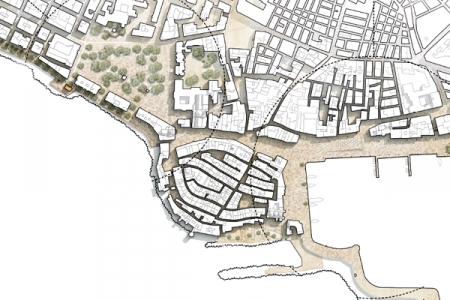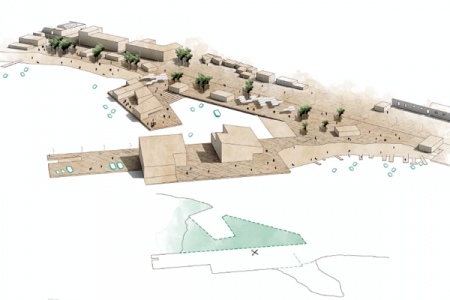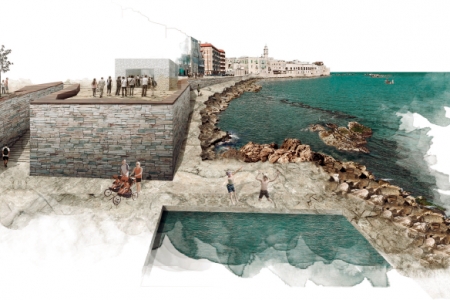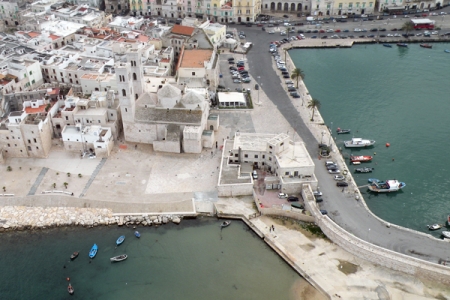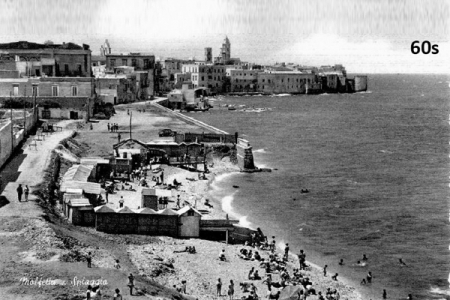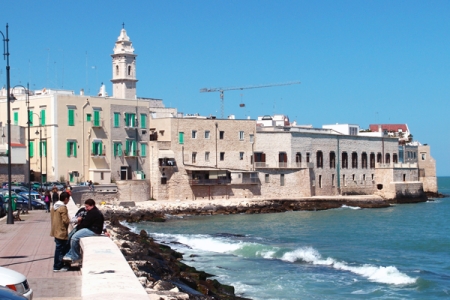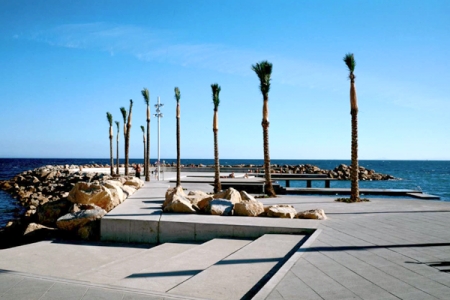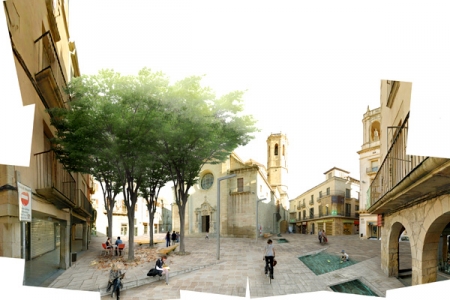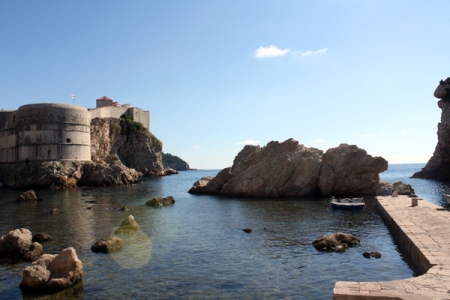Molfetta, Terra e Mare
Molfetta (IT) – Mentionné
DONNÉES DE L’ÉQUIPE
Représentante d'équipe : Barbara Piona (IT) – architecte ; Associés : Josep Ninou Carmona (ES), Luis Julio Pareda Arias (ES), Ferran Viladomat Serrat (ES) – architectes
Collaborateurs : Gabriel Casals Serrano (ES), Carles Esquerra Julià (TR) – étudiants en architecture
Elements Architectural Lab, c/ Canonge Baranera 107, 08911 Badalona – España
+34 678 511 506 – studio@elements-archlab.com – www.elements-archlab.com
Voir la liste complète des portraits ici
Voir la page du site ici

L. J. Pareda Arias, G. Casals Serrano, C. Esquerra Julià, B. Piona, F. Viladomat Serrat & J. Ninou Carmona
INTERVIEW en anglais
Cliquer sur les images pour les agrandir
1. How did you form the team for the competition?
In 2007 we started out our adventure into architecture studies and since then we have worked together on several university projects. After being awarded in different architecture competitions –urban and construction contests–, we gained confidence and experience to ultimately create our own creative platform in 2014 –Elements Architectural Lab– in order to realise our ideas, in which every member adds further relevant abilities such as engineering, visualization and photographic skills.
2. How do you define the main issue of your project, and how did you answer on this session main topic: Adaptability through Self-Organization, Sharing and/or Project (Process)?
“Molfetta, Terra e Mare” aims at the regeneration and creation of a new promenade to recover the city identity. The current relationship between land and sea as well as the high traffic density and poor parking organization have transformed Molfetta’s coastal landscape into a variety of promenades unrelated to the historical identity and tectonics of the city.
Our proposal enhances the waterfront by adding self-organizing activities for the most representative promenade points through generating new shared spaces where the city and citizens gain a higher prominence in relation to traffic.
3. How did this issue and the questions raised by the site mutation meet?
Molfetta has always been a coastal city linked to the Mediterranean and to many sea activities. The site sadly evolved from various activity areas on the waterfront during the 60’s into a space mainly captured by parking lots and roads. Consequently Molfetta's views from the sea that have been known as distinctive city features by sailors and fishermen for centuries were negatively affected. Our proposal for the development of Molfetta's coastline regains the potential of its privileged location next to the sea and strengthens the connection to the historical centre.
4. Have you treated this issue previously? What were the reference projects that inspired yours?
Yes, we grew up in the city of Barcelona. The situation helps us resolve some important problems appearing in both cities, like traffic, connection between old and new districts and also transition between city and sea.
A few years ago we were working on a project that consisted in revitalizing the main square of Tàrrega, Catalonia. Reorganizing the parking lots and connecting the main square with two other squares in the historical center of the city was our fundamental intention. With the creation of a new pedestrian axis along this area coinciding with an old stream we achieved a positive change in respect to the historical elements of the city center.
During our studies we were working on several urban regeneration projects of small villages around Spain where heritage was of main importance. In this period our training led us also to work on a Europan project in Dubrovnik. This experience helped us learn from a city with similar urban conditions and difficulties.
The following projects with Mediterranean identity gave us further inspiring ideas on finding suitable solutions for the city of Molfetta: Torrevieja's waterfornt by Carme Pinós, Paulo David in Madeira, Josep Mias in Banyoles and Malecon waterfront in la Habana.
5. Today –at the era of economic crisis and sustainability– the urban-architectural project should reconsider its production method in time; how did you integrate this issue in your project?
Our intervention consists in creating a stone promenade along Molfetta’s waterfront, reconnecting the city with the sea, recovering the characteristic view from the sea and regenerating the activities on the coastline. This stone promenade focuses on pedestrians and soft mobility as well as on different activity spots. Due to the enormous surface to develop and in order to simplify the economic and construction implementation, each spot functions as an independent element with common characteristics and objectives.
When implementing the project plan, the activity points can be constructed according to the city’s necessities and requirements. Each spot includes different activities that can be coordinated through local businesses and will finance the connections between the different points.
Considering the singularity of some points causes us to take into account not only economic and constructional aspects but also the following circumstances: on the one hand, the importance of time implementation, and on the other, the creation of different construction phases inside each spot to accommodate the current uses with the new ones without interfering with the ongoing activities.
6. Is it the first time you have been awarded a prize at Europan? How could this help you in your professional career?
Yes, it is the first time we have been rewarded as ‘Elements Arch Lab’ team in this competition although some of our members were awarded a Special Mention in 2013 on the Europan 12 Gjilan site (KO).
Currently we feel that this Europan 13 award is a great opportunity to boost our professional career. The prestige and scope of the competition is an important chance to present the work and ideas we have been developing in recent years.
